Today, we’ll be analyzing a short film on YouTube that has garnered over 2 million views. Our goal is to understand what makes this microfilm so impactful and reverse-engineer the elements that contributed to its success.
The goal of this exercise is to identify what works and what doesn’t by analyzing a short yet effective piece, with the aim of achieving similar results in the future.
The short film
The plot
The plot is simple yet highly effective. A night owl rides his bicycle to a gas station at 2 AM to grab a coffee drink. When he steps back outside, his bike is gone.
Short technical analysis
The micro-film length is around 2 minutes and has around 12 shots. I think this format is perfect for training. Here are some of the small details:
- The gas station looks amazing
- The gas station has the American cinematic vibe
- Each shot is composed with tons of care
- Each shot are creative and close to being flawless
- The blocking of the video is complex and well executed
- The music is matching the ambiance
- Sound editing although simple is very clean
- Grading match the cinematic feel with a green cold tint
- Mist filter for the blooming cinematic feel adds to the ambiance
- The sound editing is simple but effective
- The pace is very deliberate
- There is a sense of mystery
Gear
Shot with a Sony FX3, a Sony 24-70mm GM II and a Pro Mist filter
In depth analysis

The film begins with a black screen, allowing the ambient sounds and music to set the mood over the first four seconds. Initially, we hear the location’s traffic noise or white noise, followed by the gradual introduction of music. This choice is intriguing as it subtly establishes the film’s rhythm, signaling a slow, contemplative pace.
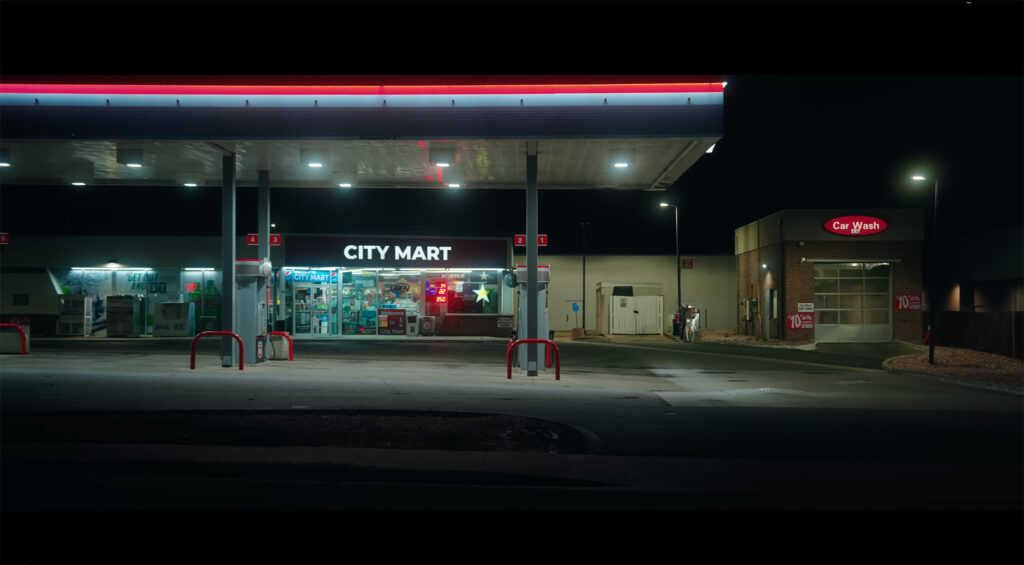
The first frame is introduced with a subtle sound effect. This shot serves as an establishing shot, carefully composed into three distinct sections: the dark sky, the illuminated station, and the shadowed concrete.
Right from this frame, the cinematic quality is evident—the glowing blooming lights, the slight green-blue tint harmonizing with the warm yellowish glow, and the striking presence of red throughout the composition.
The City Mart, which serves as the main subject, is positioned slightly off-center to the left. However, this composition works well as it creates space on the right side of the frame, allowing the main character to enter smoothly while riding his bike.
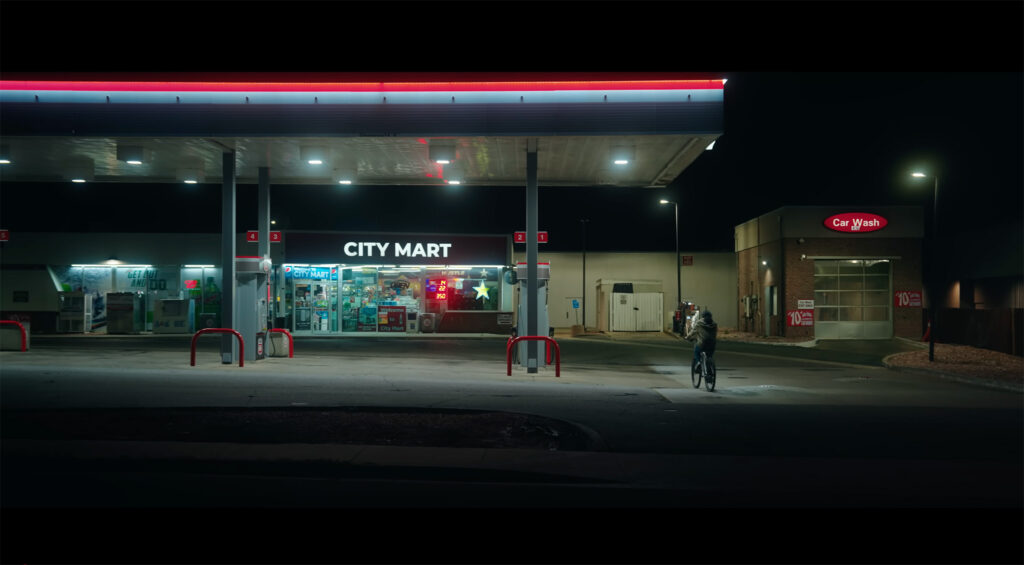
The frame features distinct pockets of light, adding depth and visual interest. As the scene unfolds, sound effects come into play, particularly the sound of the bike’s wheels. While it may not be entirely realistic, it effectively enhances the bike’s presence and immersion in the scene.
I appreciate that the first shot is locked off on a tripod. In an era where most would opt for camera movement to create engagement, this choice feels intentional—grounding the establishing shot and allowing it to linger. It highlights the contrast between the fast-paced TikTok style and the more deliberate pacing of cinematic storytelling.
The main character doesn’t just enter the frame; he also interacts with the overhead lighting in the environment, adding depth and visual interest to the shot. While the shot may appear simple, the challenge lies in making it look seamless, which requires multiple takes, especially in a somewhat public setting. Now, imagine having to do this 10 or 20 times, and you can appreciate how challenging it is to capture the perfect shot.
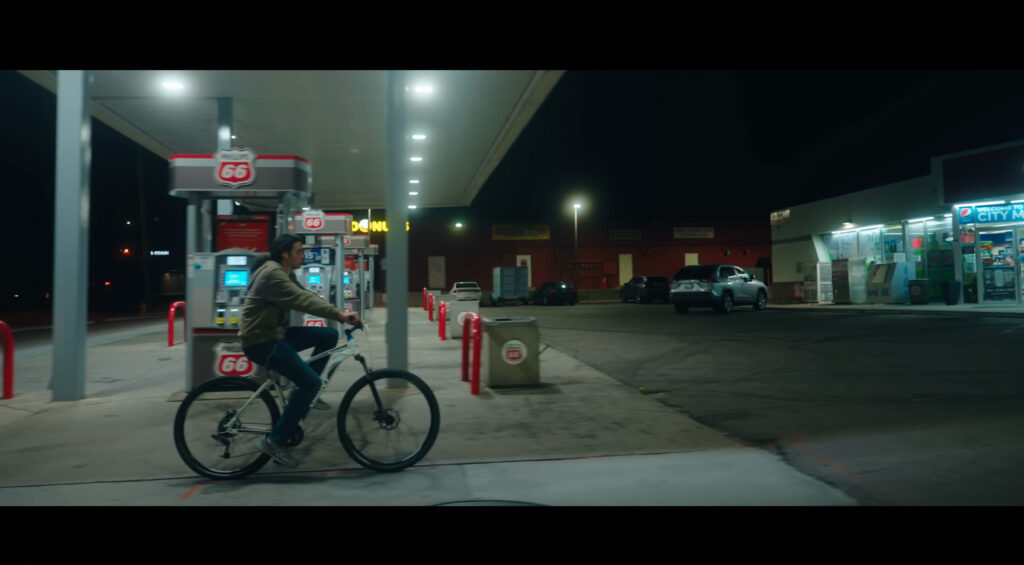
The second shot is the tracking shot which transition perfectly in terms of timing and position. The composition is again very pleasant with repeating lines of the gas pumps and lights in the ceiling. The station market is also present in the shot to give a sense of destination.
You can observe a light on the camera side which illuminates the character’s face. This light might be the sodium vapor light from the right side of the establishing shot.
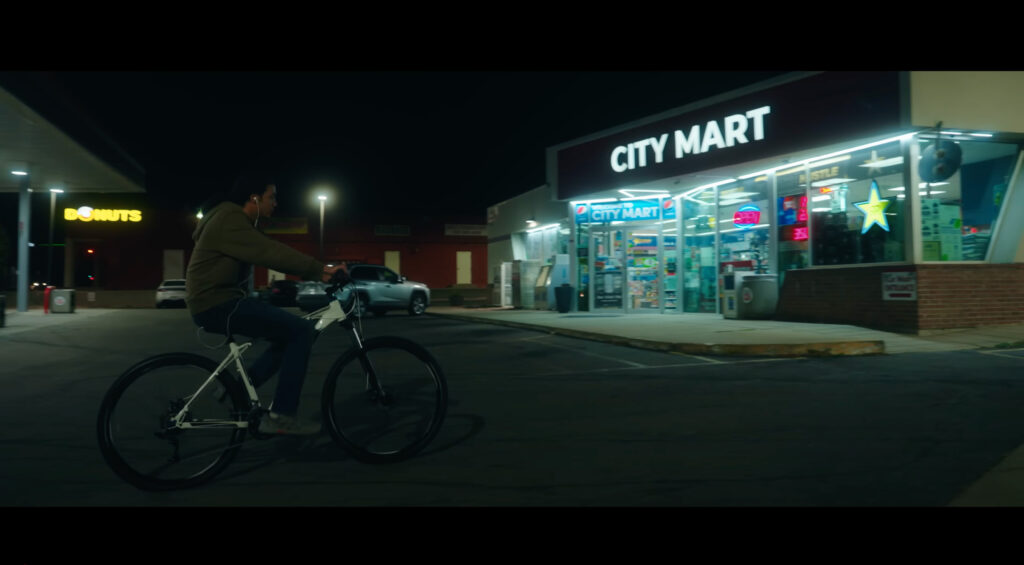
Although this shot appears simple, you can tell that the tracking is incredibly smooth, suggesting they either filmed from inside a car or used another bike for the shot. In these situations, it’s important to ensure nothing feels out of place. For instance, if a light were positioned behind the camera, it would cast an obvious shadow of the car on the scene.
Up until now, the scene has been captured with deep focus, which requires careful composition. Notice how the background is relatively free of cars, giving the location a less cluttered feel.
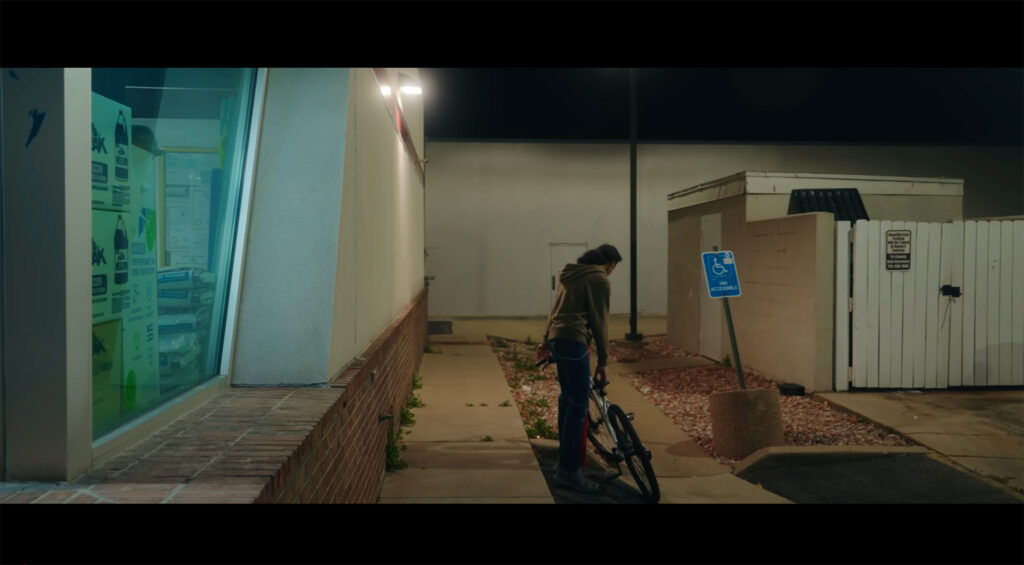
Next, in the third shot, we see another beautifully composed frame, divided into thirds, with the station store on the left consistently anchoring the location but also maintaining the consistency in the color contrast. Notice how each time we transition from one shot to the next, we shift at least 90 degrees, making the movement feel intentional and purposeful.
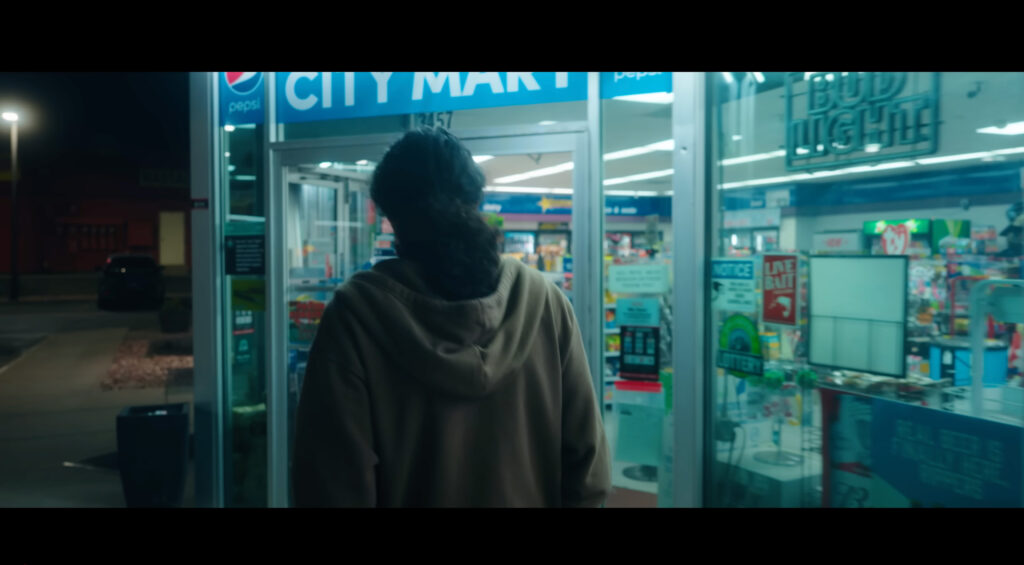
What makes this shot so effective is the seamless transition from a stationary shot to a panning shot, and then into a tracking shot. The camera stays motivated by the character’s movement, reminiscent of a Fincher film. Additionally, the exposure remains well-balanced throughout the entire shot. The subtle neon light adds a slight edge light to the character as he transitions into the store.
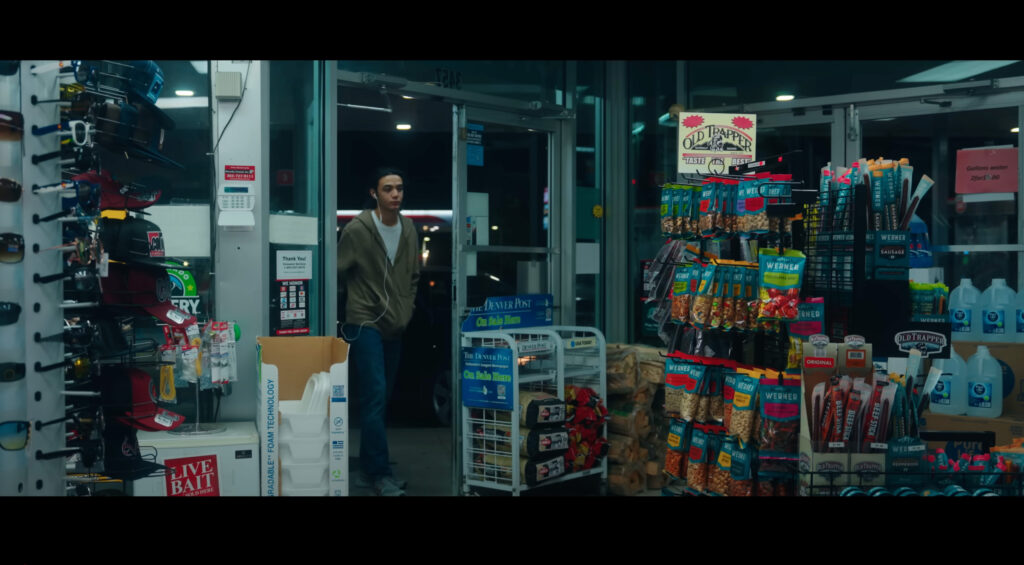
In the fourth shot, we transition seamlessly into the store’s interior with perfect timed shot from the inside. One thing that stands out is that most shots are captured with a fairly wide-angle lens, likely between 24mm and 35mm. While wide shots are more challenging to compose, they add significant depth to the scene, making the visual storytelling more immersive.
My suspicion is that they carefully set up the location to compose this shot meticulously, likely adding an extra light to ensure the subject is well-lit upon entering—while keeping it natural and unobtrusive.
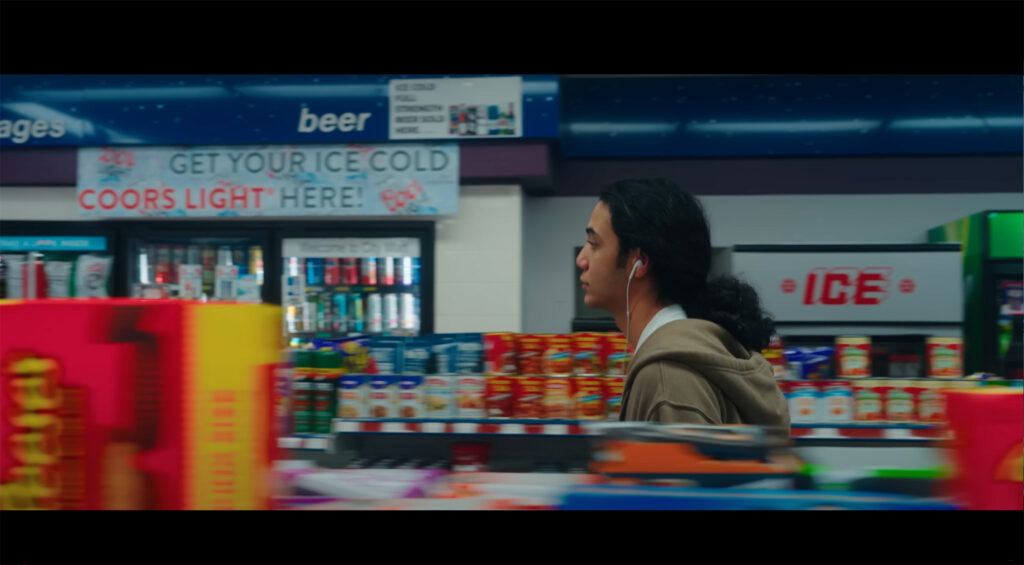
The fifth shot is a tracking shot, intriguingly moving in the opposite direction of his previous movement. These types of shots are particularly effective when multiple layers—foreground, middle ground, and background—create a parallax effect, adding depth and visual interest.
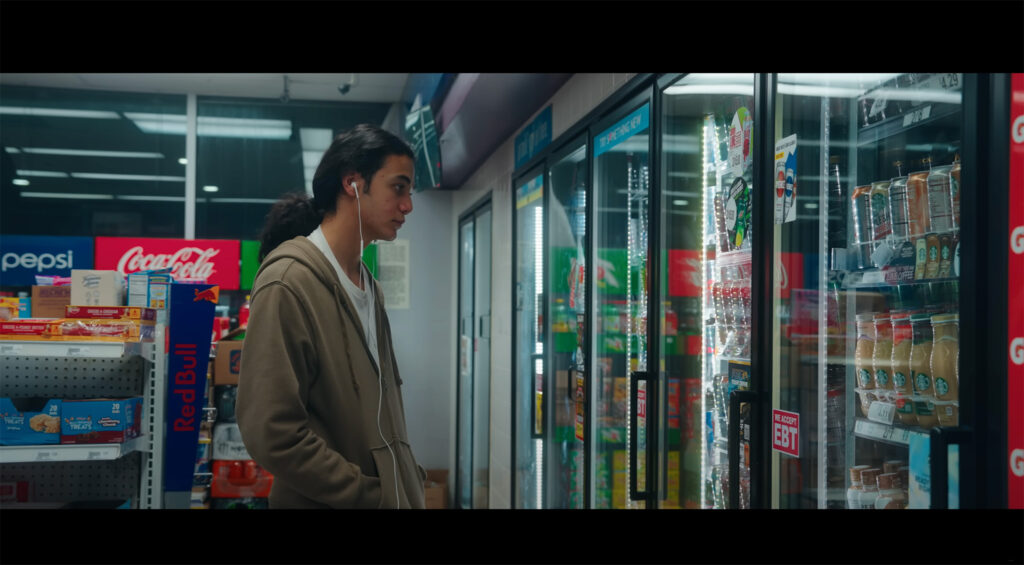
Once again, there’s a 180° shift in the camera’s position, reversing the character’s movement direction, yet it still feels seamless and effective. I also like that they tend to alternate between tracking and stationary shot.
The first part of the shot is divided into two halves, but through blocking, it naturally transitions into three distinct sections once again. These may be unconscious choices, but they work effectively from a visual standpoint.
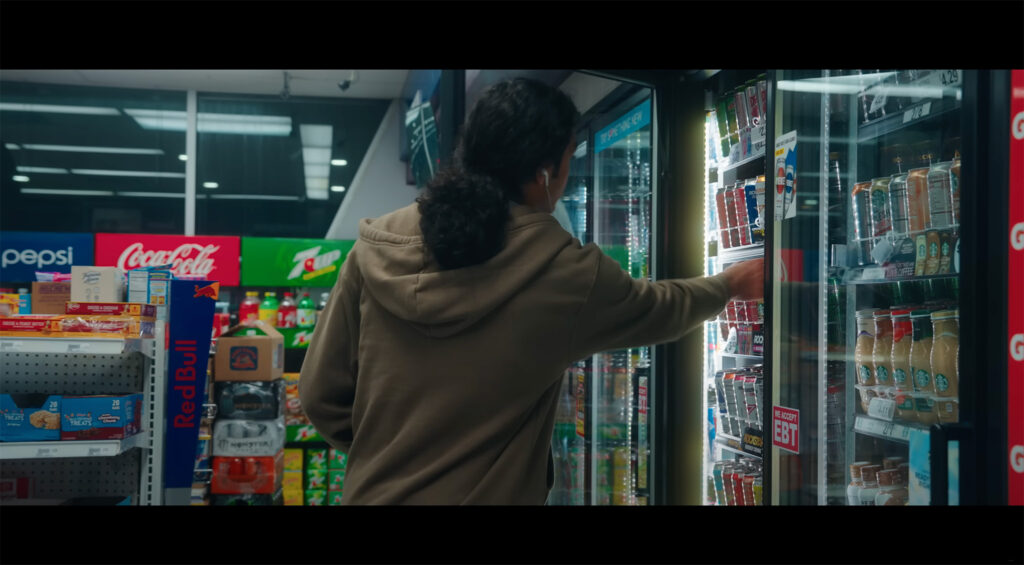
The stationary shot keeps the viewer’s focus on the character and his decision-making process, in this case, selecting his drink. I appreciate how the shot lingers, allowing the action to feel natural, and how he doesn’t have to reach up or down, keeping the blocking clean and precise. Notice how they’ve added sound effects in post-production, which bring a touch of realism and depth to the scene.
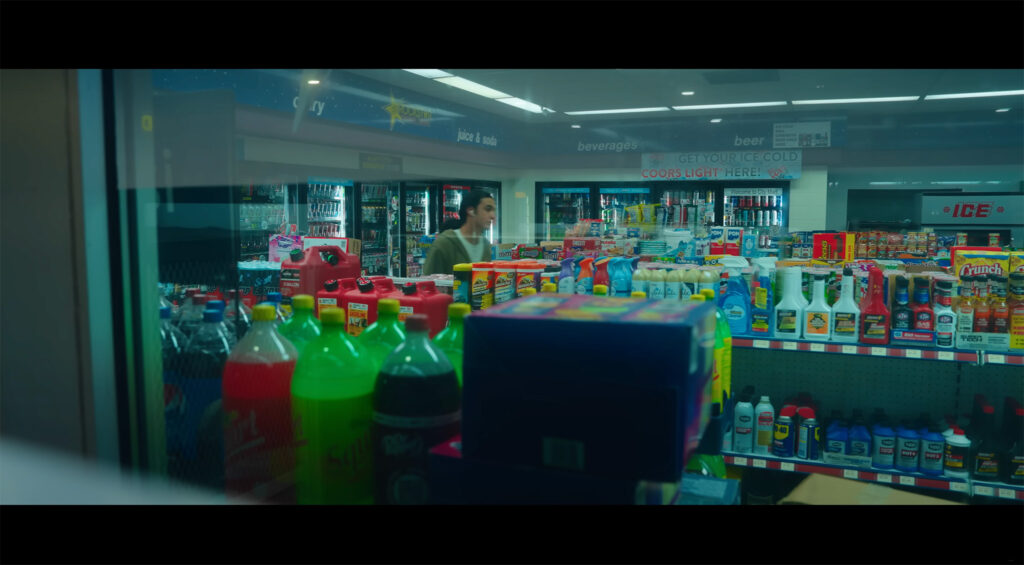
Perhaps my favorite shot in the short is the one from outside the store looking in. First, I really love the color grading, which gives a strong fluorescent tube light vibe. Then, there’s a wonderful sense of depth in this shot—outside the window, there’s the blurred row of bottles, the cleaning products on the next shelf, the row where the character is walking, and finally, the background with the fridges.
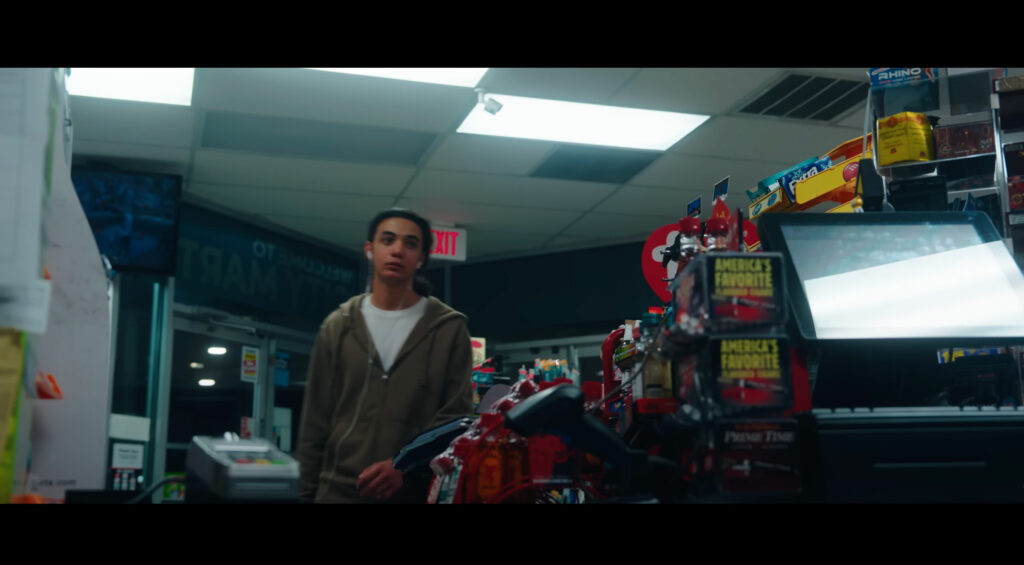
The next shot is a swift transition to the cashier. It’s a stationary shot with the focus manually adjusted to the area where the character will stop. Once again, the frame is divided into foreground, middle ground, and background. The overhead lights help create three horizontal sections, with key elements in the foreground, such as the cashier and the credit card machine, providing important information.
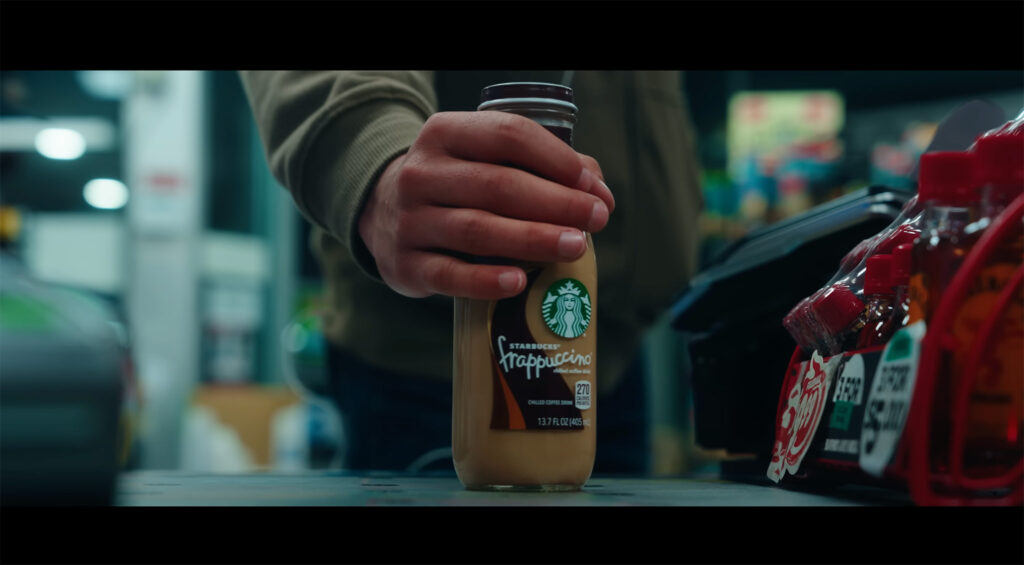
This may be the standout shot of the short, stationary and with the focus placed on the Starbucks Frappuccino bottle. It could easily double as a great ad for Starbucks. From an analytical perspective, there’s a lot happening within the three layers of the frame, making the blocking feel like a ballet.
Background : the main character brings the bottle to the counter
The middle ground : the place where the exchange is taking place, to bottle is the center of attention, it is put down by the customer.
The foreground : The cashier takes it to scan it, you can even see the light which is a nice touch
The middle ground : Drops it back to the counter
Background : while simultaneously the customer is reaching for his phone to pay.
Middle ground : finally the customer reaches to the bottle to pay
Background becomes the middle ground : as the customer reaches out to grab the bottle the focus follows back the main character as he leaves in the door in the background.
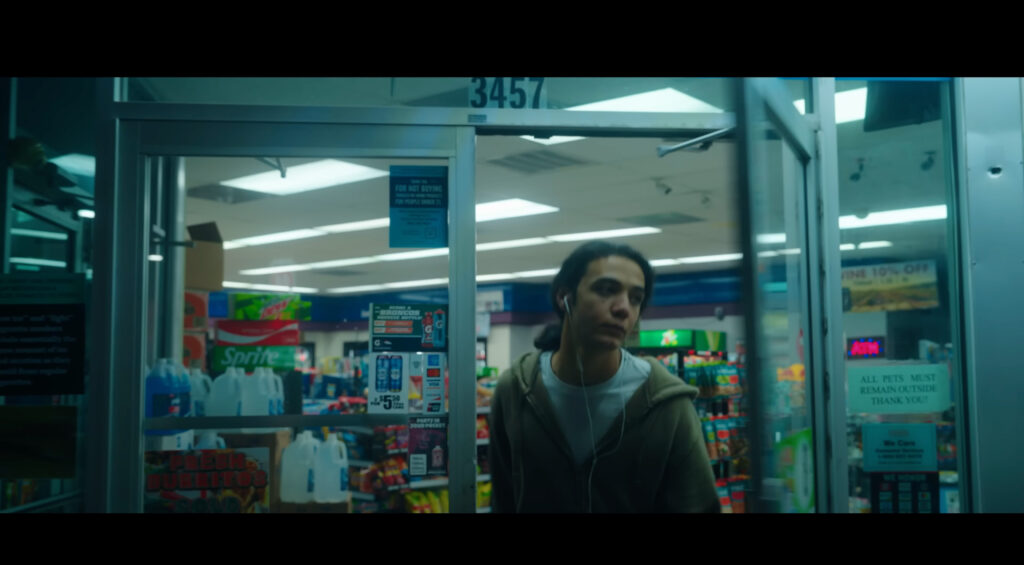
In the next shot, the camera shifts by more than 90°, creating a sense of moving to the opposite side of the previous frame. A piece of music, almost like a false ending, plays as the camera pulls in while the character exits the store almost as a conclusion.
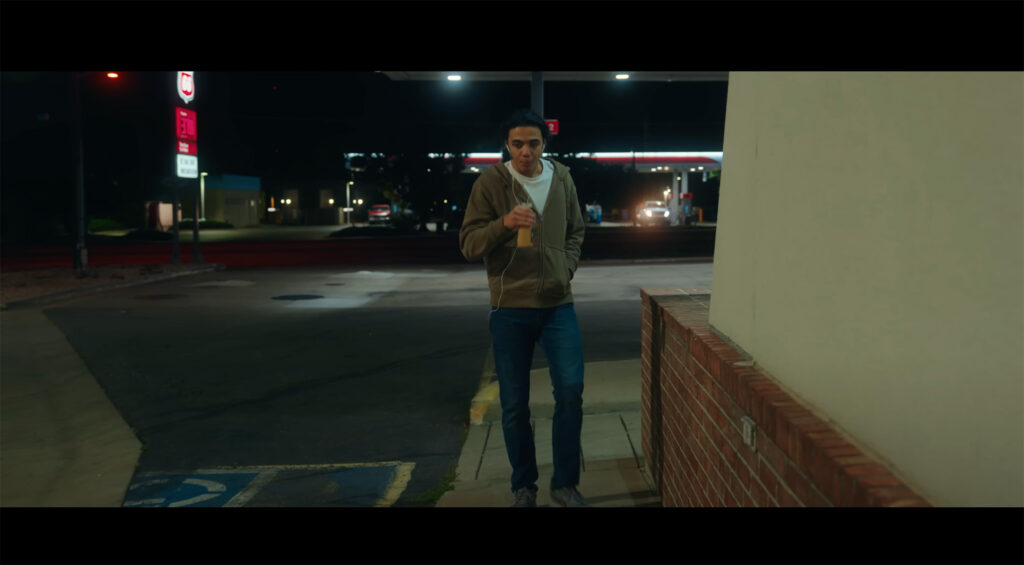
As we shift to the side of the shop, the camera pulls away from the scene, almost serving as a precursor to a reveal. As the camera pulls back, the three layers become more distinct. Observe how the character is consistently well-lit without it feeling forced, almost as if the lighting is designed for the space itself, rather than specifically for the subject.
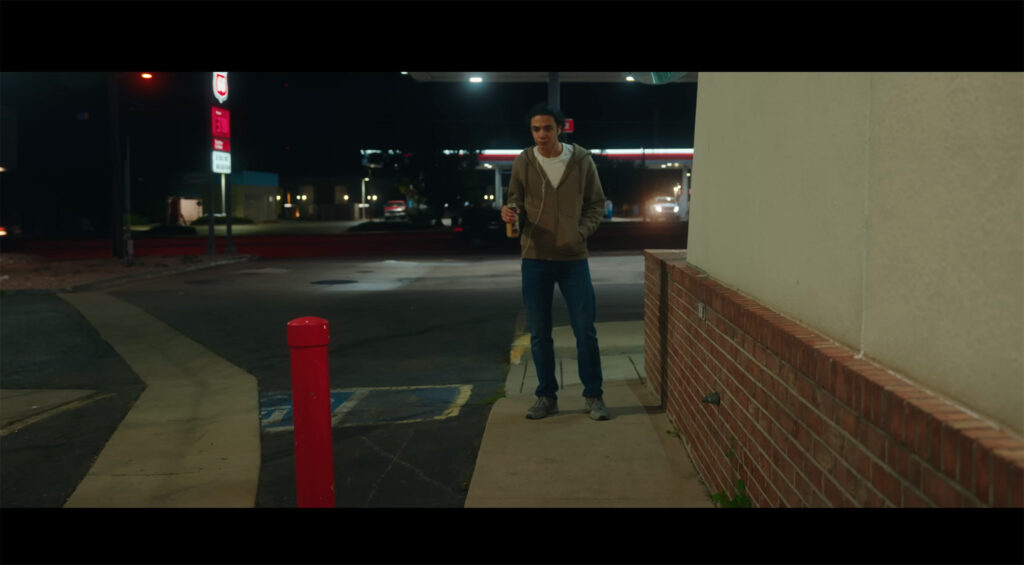
The foreground shows the space where the bike once was. I really appreciate how the background is filled with real-life elements, like passing cars and vehicles stopping to refuel across the street. These small details add a layer of realism to the scene.

The final shot serves as the conclusion of the short, delivering the final confirmation that his bike has been stolen. Once again, the composition is divided into three horizontal layers. This wide shot is visually striking, and we appreciate how the shot lingers, capturing the character in a state of shock, unable to process what has just happened.
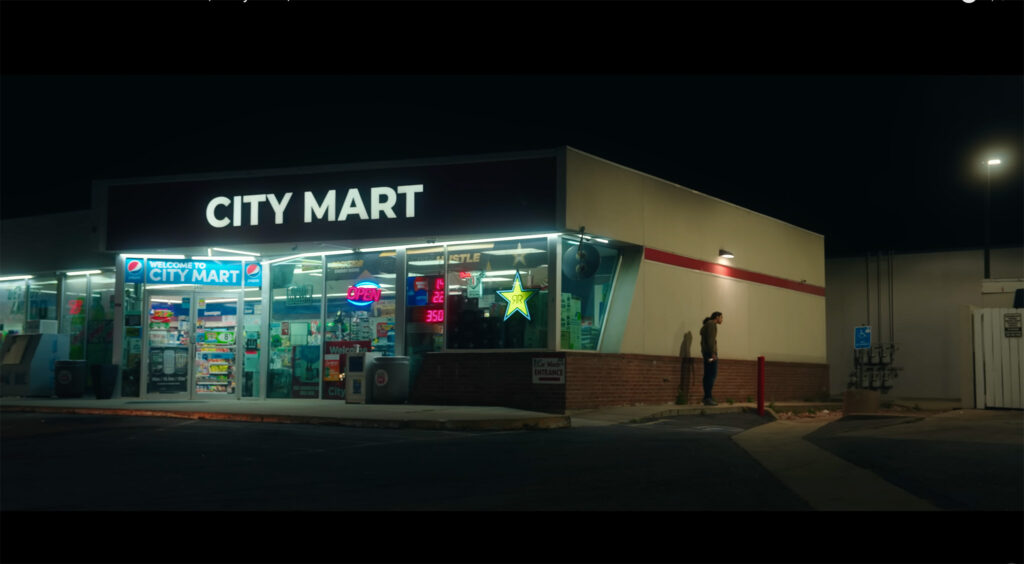
There is a sense of comedy, with the music accompanying the final blow while the scene is slowing fading out.
What we can learn from this short
- Create a short, impactful story (2 minutes, 12 shots)
- Avoid using dialogue
- Choose a stunning location that feels both cinematic and authentic
- Scout the location and plan your shots to complement the existing environment
- Shoot during quiet hours for the best atmosphere
- Dedicate ample time to refining the story and paying attention to details
- Draw a storyboard for every shot and the blocking to ensure everything aligns perfectly
Comparison with other successful short
Transmission is an incredibly technical achievement, utilizing a drone to craft an otherworldly experience reminiscent of Enter the Void by Gaspar Noé. While I truly admire this short, I believe that this level of mastery isn’t easily attainable. It would take decades of experience to execute a shot like this.
A Bad Idea is another brilliantly crafted short film, packed with sharp wit and exceptional execution. However, its complexity makes it challenging for beginners. With strong performances, impressive technical skills, and meticulous effort—especially in the precise egg-splitting sequence—this film is best suited for experienced and advanced filmmakers.
Conclusion
When watching a short film, we’re often unsure of what’s coming next. That’s why the movie begins with a sense of mystery, leaving the door open for anything—a robbery, an alien invasion, or anything else really. But by the end of the film, we’re revealed that it’s simply the story of a big letdown which many of us can relate to.
It’s amusing how, as an audience, we initially noticed the bike wasn’t secured properly, but as the scenes unfolded, we completely forgot about it—only to be reminded of it at the very end.
The level of craftsmanship in this short is truly impressive. I believe they made the perfect choice by opting for a story that is simple yet achievable, allowing them to focus on the finer details. This is what makes the short work so well, in my opinion.
Informations
2 AM Coffee
Talent: Abdulhaq Alrudaini
Director of Photography: Robidh Basnet
Writer/Director: Ayush Karki





GIPHY App Key not set. Please check settings